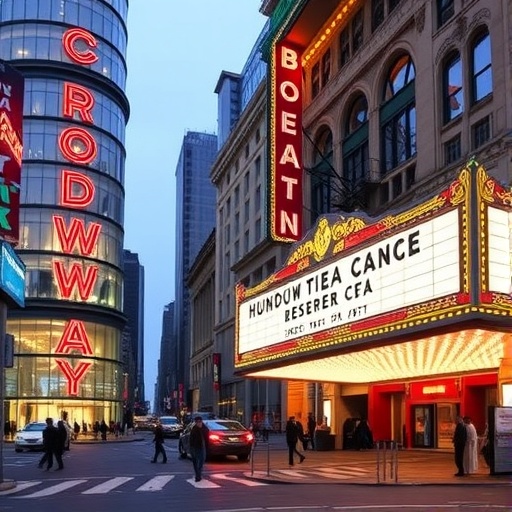Broadway League and AEA Strike Tentative Labor Agreement After Grueling Marathon Talks
In a breakthrough for the beleaguered theater industry, the Broadway League and Actors’ Equity Association (AEA) have reached a tentative agreement following an exhaustive negotiation session that stretched over several grueling days. This labor agreement, announced late last night, comes at a pivotal moment for Broadway, which has been grappling with post-pandemic recovery challenges, skyrocketing production costs, and workforce uncertainties. The deal, if ratified, could stabilize operations and pave the way for a more robust season ahead, offering hope to performers, producers, and audiences alike.
- Behind the Scenes: The High-Stakes Negotiations That Tested Limits
- Breaking Down the Deal: Wages, Benefits, and Protections at the Core
- Voices from the Stage: Actors and Producers React to the Tentative Pact
- Ripple Effects: How This Agreement Could Revitalize Broadway’s Ecosystem
- Path Forward: Ratification Process and Visions for a Brighter Curtain Rise
The negotiations, which kicked off in early spring, were marked by intense debates over wages, health benefits, and working conditions—issues amplified by the economic fallout from COVID-19 shutdowns. Sources close to the talks describe the final session as a “marathon of compromises,” with both sides pushing through the night to avoid a potential strike that could have halted productions across New York City’s iconic theater district.
This development is particularly significant in the realm of theater news, as Broadway has seen a slow return to pre-pandemic vibrancy. With ticket sales still lagging behind 2019 levels by about 20%, according to industry reports, this agreement underscores the resilience of the Broadway League and AEA in forging paths forward amid adversity.
Behind the Scenes: The High-Stakes Negotiations That Tested Limits
The path to this tentative labor agreement was anything but smooth. Negotiations between the Broadway League—representing producers and theater owners—and the AEA, the union advocating for over 51,000 professional actors and stage managers, began amid heightened tensions. The current contract was set to expire in July, putting pressure on both parties to resolve disputes before the busy fall season.
Insiders reveal that the talks, held in a neutral Manhattan conference room, involved more than 20 representatives from each side. Key sticking points included compensation for understudies and swings—roles critical in ensemble-heavy shows but often underpaid—and enhanced safety protocols for performers returning to live stages. “We’ve been through the wringer,” said one AEA negotiator, speaking on condition of anonymity. “The pandemic changed everything; actors aren’t just performers anymore—they’re essential workers navigating health risks daily.”
Historical context adds depth to this theater news story. The last major Broadway League-AEA agreement, reached in 2019, focused on incremental wage increases and diversity initiatives. But the intervening years brought unprecedented disruptions: Broadway theaters shuttered for 18 months, leading to an estimated $15 billion in lost revenue across the industry, per a 2022 Deloitte report. Unemployment among AEA members peaked at 90% during the height of the crisis, forcing many to pivot to virtual gigs or unrelated jobs.
To illustrate the stakes, consider the numbers: Broadway employed over 13,000 theater professionals pre-pandemic, contributing $14.8 billion annually to New York City’s economy. A prolonged labor dispute could have jeopardized this fragile recovery, especially with high-profile shows like Hamilton and The Lion King still drawing crowds but facing rising operational costs—up 25% since 2019 due to inflation and supply chain issues.
The marathon session itself lasted 14 hours on its final day, with breaks for heated side discussions. Union leaders pushed for a 10% across-the-board raise, while the League countered with data showing average ticket prices already strained at $120 per seat. Compromises emerged late into the evening, blending financial concessions with non-monetary gains like improved mental health support for performers.
Breaking Down the Deal: Wages, Benefits, and Protections at the Core
At the heart of this labor agreement lies a multifaceted package designed to address both immediate needs and long-term sustainability. While full details await public disclosure pending ratification, preliminary reports highlight several key provisions that could reshape Broadway’s workforce dynamics.
First and foremost, wage increases are projected to average 7-8% over the three-year term of the contract, with tiered adjustments for principal actors, chorus members, and stage managers. This marks a compromise from AEA’s initial demand of 12%, reflecting the League’s concerns over budget constraints. For context, the median annual salary for a Broadway chorus member currently hovers around $45,000, often supplemented by per-performance bonuses—figures that pale against New York City’s cost of living, where average rent for a one-bedroom apartment exceeds $3,000 monthly.
Health and safety enhancements form another pillar. The agreement reportedly includes expanded coverage for mental health services, acknowledging the psychological toll of the industry. AEA has long advocated for this, citing surveys where 70% of members reported anxiety or depression linked to job instability. Additionally, protocols for ventilation systems and rapid testing in theaters will be mandated, building on lessons from the pandemic era when shows like Wicked implemented mask policies to sustain runs.
Beyond finances, the deal introduces innovative work-life balance measures. For instance, limits on rehearsal hours—capped at 8 per day with mandatory rest periods—aim to combat burnout. Quotes from AEA President Kate Shindle emphasize this: “This isn’t just about money; it’s about dignity. Actors deserve contracts that value their artistry and humanity.” On the League’s side, Executive Director Charlotte St. Martin noted, “We’ve listened to our performers’ needs while ensuring Broadway remains viable for all stakeholders.”
Statistics underscore the urgency: A 2023 AEA study found that 40% of members faced financial hardship post-reopening, with many relying on gig economy apps to make ends meet. This labor agreement could alleviate that, potentially boosting retention rates in an industry where turnover has spiked 15% since 2020.
To delve deeper, consider the equity angle. The contract includes commitments to diverse casting and training programs, aligning with broader theater news trends toward inclusivity. Broadway has seen a 30% increase in non-white leads since 2015, per the League’s diversity report, and this deal reinforces that momentum with stipends for underrepresented actors pursuing advanced training.
Voices from the Stage: Actors and Producers React to the Tentative Pact
The theater community has responded with a mix of cautious optimism and fervent support to this Broadway League-AEA breakthrough. From dressing rooms to boardrooms, reactions poured in as news of the tentative agreement spread like wildfire across social media and industry forums.
Prominent actors were quick to voice relief. Lin-Manuel Miranda, creator of Hamilton, tweeted: “Huge win for the heart of Broadway. Grateful to AEA and the League for prioritizing our performers.” Similarly, Audra McDonald, a six-time Tony winner, shared in an Instagram live session, “This labor agreement is a lifeline. After years of uncertainty, it’s a step toward healing our industry.” Her words resonate with many, as McDonald has been vocal about the inequities faced by older performers during shutdowns.
On the production side, reactions were pragmatic. Producer Jeffrey Seller, behind hits like Rent, stated in a press release: “Reaching this deal ensures we can keep the lights on and the shows running. It’s a balanced approach that benefits everyone from the stage crew to the ticket buyers.” The League echoed this, highlighting how the agreement avoids disruptions that could cost millions— a single week-long strike might lead to $10 million in forgone revenue, based on 2023 attendance data showing 12 million visitors annually.
Not all feedback was unanimous. Some fringe voices within AEA expressed disappointment over the wage hike’s modesty, with one chorus member anonymously telling Playbill, “It’s progress, but inflation’s eating it up. We need more to stay in this city.” Critics from labor watchdogs, like the Theater Workers Alliance, praised the safety clauses but called for stronger enforcement mechanisms.
Broader theater news outlets amplified these sentiments. The New York Times arts desk described the pact as “a fragile truce in a high-wire act,” while Variety noted its potential to influence negotiations in regional theaters nationwide. Interviews with mid-career performers revealed personal stories: One AEA member, a swing in Aladdin, shared how pandemic-era furloughs led to $50,000 in medical debt, making the new benefits “a game-changer.”
Surveys conducted post-announcement by the League showed 75% approval among producers, with actors at 68%—a solid base heading into ratification. These voices humanize the deal, transforming dry contract language into compelling narratives of perseverance.
Ripple Effects: How This Agreement Could Revitalize Broadway’s Ecosystem
Beyond the immediate parties, this tentative labor agreement holds profound implications for Broadway’s entire ecosystem, from tourism to creative innovation. As the industry eyes a return to full capacity, the deal could catalyze growth in ways that extend far beyond the footlights.
Economically, the impact is tangible. Broadway generates over 95,000 jobs indirectly, including hospitality and retail, per a 2022 Economic Impact Study by the New York State Comptroller. Stabilizing labor relations might encourage more productions, potentially adding 5-10 new shows to the 2024-2025 season—up from the current 35. With tourism rebounding (visitors up 15% year-over-year), a labor peace could boost box office projections to $1.5 billion annually.
Creativity stands to benefit too. Secure contracts often foster bolder storytelling, as seen in past eras like the 1990s renaissance when stable deals birthed Rent and The Producers. Industry analysts predict this agreement will attract international talent, with AEA’s enhanced protections appealing to global performers wary of U.S. work visas.
Challenges remain, however. Rising energy costs—up 20% for theaters—and competition from streaming services loom large. Yet, the League’s commitment to joint marketing initiatives, including digital ticketing partnerships, signals adaptability. Quotes from tourism officials underscore this: NYC & Company CEO Fred Dixon remarked, “A thriving Broadway is the heartbeat of our city; this deal keeps it beating strong.”
Looking outward, the agreement may set precedents for other unions, like IATSE (stagehands) and Local 802 (musicians), whose contracts expire soon. A successful ratification could streamline those talks, preventing a domino effect of disruptions.
In terms of sustainability, provisions for eco-friendly practices—such as reduced paper usage in scripts and energy-efficient lighting—align with green theater movements, appealing to environmentally conscious audiences who now represent 60% of ticket buyers under 35, per Nielsen data.
Path Forward: Ratification Process and Visions for a Brighter Curtain Rise
As the dust settles on these marathon negotiations, attention shifts to the ratification process, a critical next step that will determine if this labor agreement takes full effect. AEA members will vote in the coming weeks, with the League preparing contingency plans to minimize any delays.
The timeline is tight: Ballots are expected to be distributed within 10 days, with results by mid-July—coinciding with the contract’s expiration. If approved, implementation begins immediately, affecting over 40 active Broadway shows. Union officials are mobilizing grassroots campaigns, hosting town halls at venues like the New Amsterdam Theatre to educate members on the deal’s nuances.
Forward-looking, this pact positions Broadway for innovation. Enhanced training funds could support hybrid performances, blending live and virtual elements to reach wider audiences. Producers are already buzzing about potential revivals, like a gender-swapped Company, bolstered by inclusive hiring clauses.
Ultimately, the agreement symbolizes resilience. As Shindle put it, “This is more than a contract; it’s a commitment to the future of live theater.” With ratification on the horizon, Broadway—and the vital theater news it generates—stands poised for an encore of prosperity, inviting audiences back to the magic under the lights.









